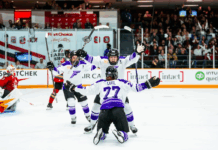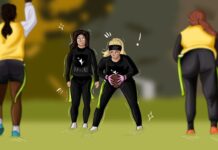Nadine Smith is rarely stationary.
As Carleton University’s head athletic therapist, Smith seldom spends more than a few minutes at a time seated in her office at the school’s athletic therapy clinic.
She is much more likely to be rushing between injured athletes and concerned coaches, dodging exercise equipment from every possible angle as she goes.
“It’s never not busy here,” Smith laughs once she is settled at her desk.
“It’s definitely a lot to keep track of, though I probably wouldn’t be able to imagine it another way.”
An Ottawa native, Smith was raised on a military base in the city’s east end, spending much of her childhood engaging with the“community-oriented” nature of military life.
“All the activities that I participated in were always on the base, whether it was figure skating, or tee-ball or soccer,” she says.
“Everybody took care of everybody else, and that idea of looking out for each other has certainly fed into my job now.”
Smith’s call to athletic therapy came during her first year studying human kinetics at the University of Ottawa, when the school’s head athletic therapist spoke to one of her classes about the profession.
“As soon as he told everybody what athletic therapy was, I went up to him immediately and said, ‘I think this is what I want to do—how can I do it?’”
After completing her graduate studies at York University in Toronto, Smith returned to Ottawa in 1999 to work as a contracted athletic therapist at Carleton, where she made a significant impression at the men’s national soccer championships in Victoria.
“I was never a guy who was injured all the time,” says Kwesi Loney, former Carleton Ravens men’s soccer player and current coach of the same team.
“But at that tournament, I suffered a severe concussion, and Nadine took extremely good care of me.”
“Obviously [the team] was away at the time, and you can imagine any parents whose child calls them and says, ‘Hey, I have a concussion’—a lot of red flags there—but the amount of stuff Nadine did for me, especially with reassuring my parents I was gonna be okay, it really demonstrated the quality of the individual that she is.”
After renewing her contract several times with the Ravens, Smith took on the position as Carleton’s head athletic therapist in 2005, overseeing the school’s athletic therapy operations ever since.
Despite the time she has spent working with athlete after athlete, the quality of Smith’s work has yet to wane, says Gabrielle Nickoluk, Smith’s athletic therapy assistant of 11 years.
“Regardless of how busy we are, Nadine is always in a good mood and uplifting,” she says.
“She’s everyone’s go-to person when it comes to mental health stuff, return-to-play protocols, and communicating with coaches in the off-season, no matter the team.
“You wouldn’t know she’s got that much on her mind because she’s still able to pay attention to you—she’s always in the moment with people.”
“When someone’s talking to you, you should be looking at them and engaging with them —especially when it’s high-stakes, like at nationals,” said Smith.
“You don’t want to be what creates anxiety or stress for [the athletes].”
Despite working at Carleton for more than two decades, Smith’s commitment to the school has yet to deter her from other pursuits.
In the span of her 21-year career, Smith has worked at three Canada Games, three World University Games, and a Pan American Games.
However, Smith says she still has one sporting event left to attend before she is ready to stow her therapy bag away for good—the Olympics.
“I think I’m a pretty empathetic person to begin with,” she says.
“But working at these major games, I think it gives me more insight into how to deal with any athlete that’s having issues, especially with their return-to-play decision.”
It’s Smith’s empathy, says Loney, that makes her “what an athletic therapist should look like.”
“What makes her so good at her job is all about the relationships she’s able to create,” he says.
“I’m an alumnus myself, but I can say that when a lot of alumni come back to the university to visit, the first person they go to see is her.”
As Smith inches closer to retirement, she says the influences she has received from those within the Ravens community will stay with her through her greatest accomplishments—her children.
“I’ve taken all those influences I’ve had from all of the coaches and all of the athletes in order to sort of mould my kids into who I want them to be—healthy, compassionate people,” she says.
“When I retire, I want to take time for myself, for my family,” she adds.“But I’m also looking forward to looking back at what I did, who I affected, and who affected me.”
Feature image by Pascale Malenfant






